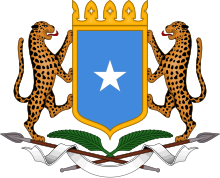أكيشو
| البلد |
|---|
| اللغة الأم |
|---|
| مجموعات ذات علاقة |
|---|
 |
| القبائل الصومالية |
|---|
أكيشو (بالصومالية: Akiisho) هي قبيلة صومالية شمالية، وهي من البطون الفرعية لشجرة قبيلة الدِر.
نظرة عامة
[عدل]تمتلك أكيشو روابط مباشرة مع قبائل عيسى، وجادابورسي، وسري (عبدال وقبيس)، وبيمال (التي تنتمي إليها عشيرة جادسن أيضاً)، وبورسوق، وغرغرا، (عشيرة القرانيو على وجه التحديد حيث يزعمون أنهم ينحدرون من دِر)، غاريير، وعشائر الدِر الأخرى ولديهم روابط مباشرة مع مجموعات عشائر هوية (عرير)، حوادله، عجوران، دغودي، الجعل، الذين يشتركون في نفس السلف لـصمالي [الإنجليزية].[1][2][3][4][5][6][7]
توزيعها
[عدل]تسكن قبيلة أكيشو كلاً من أرض الصومال وإثيوبيا، وخاصة في كل من المنطقة الصومالية ومنطقة أوروميا. يعيش أفراد أكيشو في أرض الصومال ضمن منطقة وقويي جالبيد، في مدن وبلدات هرجيسا؛ عربسيو، وجاله، ألايباداي، وغابيلي. تعد أكيشو من بين الجماعات الصومالية الأكثر انتشاراً في إثيوبيا، حيث يسكن أفراد أكيشو جيجيجا، كوردهير، ديري. ديوا، بيل (ناجيل)، بابيلي، فايانبيرو، قبري بيه، فيق، هارا مايا، هرار، أوبرا، ودادار، فاديجا جودانتا بورال جرسوم والعديد من المناطق الجغرافية الأخرى. ومحي الدين أوداوا هو سلطان عشيرة أكيشو حالياً.
كما تعد عشيرة أكيشو، إلى جانب كونها عشيرة رئيسية في الدِر، واحدة من أكبر عشائر الدِر الفرعية داخل حدود منطقة أرض الصومال التابعة لإثيوبيا بناءً على التعداد السكاني الإثيوبي.[8] يعيش العديد من شعب أكيشو في منطقة عفر في إثيوبيا.[9]
وتعيش قبيلة أكيشو في منطقة جيجيجا حيث تشكل جزءاً كبيراً من منطقة قبري بيه وفافان. تمثل أكيشو إلى جانب عشائر غرغرا وعيسى وجادابورسي المتفرعة من قبيلة دِر، أكثر القبائل الصومالية المحلية والأصلية في هرر.[10][11][12]
شخصيات بارزة
[عدل]طالع أيضاً
[عدل]المصادر
[عدل]- ^ Lewis, I. M. (1 Jan 1998). Peoples of the Horn of Africa: Somali, Afar and Saho (بالإنجليزية). Red Sea Press. p. 25. ISBN:9781569021057. Archived from the original on 2022-11-12.
- ^ Lewis, I. M. (1 Jan 1998). Peoples of the Horn of Africa: Somali, Afar and Saho (بالإنجليزية). Red Sea Press. ISBN:9781569021057. Archived from the original on 2022-11-12.
At the end of the book "Tribal Distribution of Somali Afar and Saho"
- ^ Verdier, Isabelle (31 May 1997). Ethiopia: the top 100 people (بالإنجليزية). Indigo Publications. p. 13. ISBN:9782905760128. Archived from the original on 2024-05-22.
- ^ Hayward, R. J.; Lewis, I. M. (17 Aug 2005). Voice and Power (بالإنجليزية). Routledge. p. 242. ISBN:9781135751753. Archived from the original on 2024-05-22.
- ^ The Quranyo section of the Garre claim descent from Dirr, who are born of the Irrir Samal. UNDP Paper in Keyna http://www.undp.org/content/dam/kenya/docs/Amani%20Papers/AP_Volume1_n2_May2010.pdf نسخة محفوظة 17 May 2018 على موقع واي باك مشين.
- ^ Adam, Hussein Mohamed; Ford, Richard (1 Jan 1997). Mending rips in the sky: options for Somali communities in the 21st century (بالإنجليزية). Red Sea Press. p. 127. ISBN:9781569020739. Archived from the original on 2023-01-23. Retrieved 2018-02-21.
- ^ Ahmed, Ali Jimale (1 Jan 1995). The Invention of Somalia (بالإنجليزية). The Red Sea Press. p. 121. ISBN:9780932415998. Archived from the original on 2024-05-22.
- ^ Federal Democratic Republic of Ethiopia Central Statistical Agency Population of Ethiopia for All Regions At Wereda Level from 2014 p. 21 Somali region نسخة محفوظة 23 September 2015 على موقع واي باك مشين.
- ^ Negatu, Workneh; Research, Addis Ababa University Institute of Development; Center, University of Wisconsin—Madison Land Tenure; Foundation, Ford (1 Jan 2004). Proceedings of the Workshop on Some Aspects of Rural Land Tenure in Ethiopia: Access, Use, and Transfer (بالإنجليزية). IDR/AAU. p. 43. Archived from the original on 2023-04-12.
Page:43 : Somali Settlers Akisho in Karrayu territory(Oromia region)
- ^ Slikkerveer (28 Oct 2013). Plural Medical Systems in the Horn of Africa: The Legacy of Sheikh Hippocrates (بالإنجليزية). Routledge. p. 140. ISBN:9781136143304. Archived from the original on 2024-05-22. Retrieved 2020-12-06.
- ^ Lewis, I. M. (1998). Saints and Somalis: Popular Islam in a Clan-based Society (بالإنجليزية). p. 100. ISBN:9781569021033. Archived from the original on 2023-01-12.
- ^ Lewis, I. M. (17 Mar 2003). A Modern History of the Somali: Nation and State in the Horn of Africa (بالإنجليزية). ISBN:9780821445730. Archived from the original on 2024-05-22. Retrieved 2020-12-06.
- ^ Futūḥ al-Ḥabasha. (n.d.). Christian-Muslim Relations 1500–1900. doi:10.1163/2451-9537_cmrii_com_26077
المراجع
[عدل]- Futūḥ al-Ḥabasha. (n.d.). Christian-Muslim Relations 1500–1900. doi:10.1163/2451-9537_cmrii_com_26077
- Country Information and Policy Unit, Somalia Assessment 2001, Home Office, Great Britain
Bryden, Matt. UNRISD, Nairobi. 16 June 1998. Letter received by electronic mail. Gilkes, Patrick. September 1994. The Price of Peace: Somalia and the United Nations 1991–1994. Bedfordshire, UK: Save the Children Fund, UK. Additional Sources Consulted Africa Confidential [London]. January – May 1998. Vol. 39. Nos. 1–11. _____. January – December 1997. Vol. 38. Nos. 1–25. Africa Research Bulletin: Political, Social and Cultural Series [Oxford]. January – May 1998. Vol. 35. Nos. 1–4. _____. January – December 1997. Vol. 34. Nos. 1–11. Country Reports on Human Rights Practices for 1997. 1998. Horn of Africa Bulletin [Uppsala]. Vol. 10. Nos. 1–2. _____. January – December 1997. Vol. 9. Nos. 1–10. The Indian Ocean Newsletter [Paris]. January – June 1998. Nos. 793–815. _____. January – December 1997. Nos. 747 – 792.

